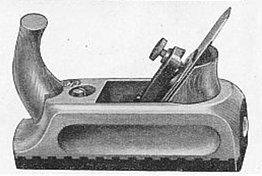While the use of wooden planes declined in North America, the same could not be said elsewhere. In the great bastion of plane-making, England, the preference was more for an amalgam of wood and steel: the infill plane. Not that the idea was anything new. Turn back the clock 2000 years to the times of the Romans, and one will find metal planes with a wooden core. So whilst North America surged ahead with the notion of completed metal planes (apart from the handles), across the Atlantic, infill planes evolved. These planes pre-date those in the the America’s likely appearing in the late 1700’s, as high-end mitre planes. The method of construction involved joining plates of iron using dovetails to form a “box”, which would be filled with wood held in place by screws or pins. These mitre planes may have been the fore-bearers of the block plane, being used to shear end-grain fibres. The method of construction differentiated these planes from their cross-ocean brethren, as casting was still in its infancy.

Apart from North America, and the U.K., metal planes did not largely impact wooden plane makers on mainland Europe, or Asian countries like Japan, where wooden plane manufacturing is still alive. It is hard to understand why metal planes did not take off in Europe as they did eventually across the channel. Tradition? In the Germanic countries there has always been a long tradition in the use of wooden planes. In Germany, where horned wooden planes are king, there are companies like E. C. Emmerich, and Ulmia which today still manufacture a large number of wooden planes. In France, there were tool companies like Goldenberg. The Japanese also continue to produce simple wooden planes that work exceptionally well. Recently, wooden planes have made a comeback in North America through the likes of bespoke makers like J Wilding.








